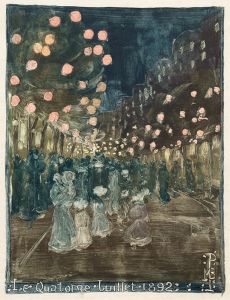
Millbank
A hand-painted replica of James Abbott McNeill Whistler’s masterpiece Millbank, meticulously crafted by professional artists to capture the true essence of the original. Each piece is created with museum-quality canvas and rare mineral pigments, carefully painted by experienced artists with delicate brushstrokes and rich, layered colors to perfectly recreate the texture of the original artwork. Unlike machine-printed reproductions, this hand-painted version brings the painting to life, infused with the artist’s emotions and skill in every stroke. Whether for personal collection or home decoration, it instantly elevates the artistic atmosphere of any space.
James Abbott McNeill Whistler was an American artist known for his paintings and etchings, and he played a significant role in the aesthetic movement. One of his works, "Millbank," is a notable example of his artistic style and approach. Whistler was born in 1834 in Lowell, Massachusetts, and spent much of his career in Europe, particularly in London and Paris. He is best known for his innovative use of color and his focus on the harmony of composition, often drawing inspiration from music, which he believed had a parallel relationship with art.
"Millbank" is part of Whistler's series of London-based works, capturing the atmospheric qualities of the city. The painting depicts a view of the Thames River, focusing on the area around Millbank, which is located in the heart of London. This area is historically significant, as it was once the site of the notorious Millbank Prison, which was operational from 1816 to 1890. The prison was known for its harsh conditions and was eventually demolished, with the site later becoming the location for the Tate Britain art gallery.
Whistler's depiction of Millbank is characterized by his signature style, which emphasizes mood and atmosphere over detailed representation. He often employed a limited color palette and soft, blurred lines to create a sense of tranquility and introspection. This approach is evident in "Millbank," where the muted tones and gentle brushwork evoke the misty, overcast weather often associated with London. Whistler's technique reflects his interest in capturing the ephemeral qualities of light and atmosphere, a hallmark of his work.
The painting is part of Whistler's broader exploration of the Thames River, which he depicted in numerous works throughout his career. These paintings often focused on the river's changing moods and the interplay of light and shadow on its surface. Whistler's Thames series is notable for its influence on the development of tonalism, a style that emphasizes the use of color and tone to create mood and atmosphere.
Whistler's work, including "Millbank," was not always well-received during his lifetime. His emphasis on mood and abstraction over realism was sometimes criticized by contemporary audiences and critics. However, his innovative approach to composition and color has since been recognized as a significant contribution to the development of modern art. Whistler's influence can be seen in the work of later artists, including the Impressionists and the American tonalists.
Today, Whistler is celebrated as a pioneering figure in the art world, and his works are held in major collections around the world. "Millbank" and other paintings from his Thames series continue to be studied and appreciated for their unique approach to capturing the essence of a place and moment in time. Whistler's legacy endures through his contributions to the aesthetic movement and his impact on the evolution of modern art.


















